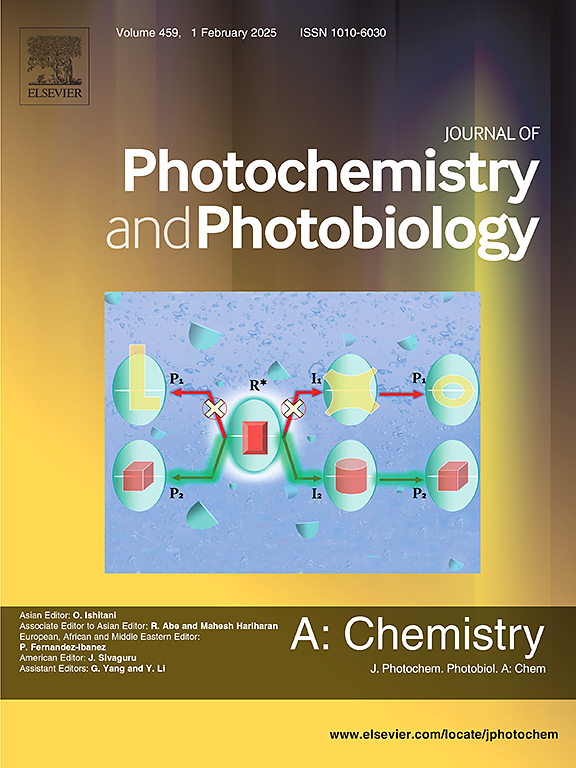Ultra-sensitive optical waveguide sensor with D–π–A chromophore for fluoride ion detection
IF 4.1
3区 化学
Q2 CHEMISTRY, PHYSICAL
Journal of Photochemistry and Photobiology A-chemistry
Pub Date : 2025-06-22
DOI:10.1016/j.jphotochem.2025.116593
引用次数: 0
Abstract
We present a polymer optical waveguide sensor for fluoride ion (F−) detection utilizing D–π–A dipolar molecules functionalized with tert-butyl dimethyl siloxane (TBS) groups. The sensing mechanism relies on F−-induced cleavage of Si![]() O bonds through a desilylation reaction, which triggers a corresponding fluorescence quenching at 607 nm. By employing a 532 nm excitation laser and exploiting evanescent field interactions at waveguide interfaces, we developed an optical sensing platform that enables both qualitative identification and quantitative measurement of trace F− concentrations through real-time fluorescence monitoring. The sensor demonstrates exceptional performance with an ultra-low detection limit of 2.25 ppb and rapid response characteristics (≈3 s). The device architecture permits configuration into multiple parallel detection channels, making it particularly promising for high-efficiency environmental monitoring and biomedical applications requiring simultaneous multi-sample analysis. Furthermore, the sensor exhibits excellent anti-interference capability and specific detection performance, demonstrating reliable detection characteristics both in the presence of other interfering substances and in practical sample applications. The combination of superior sensitivity, rapid response, and scalable design positions this platform as a significant advancement in optical chemical sensing technology
O bonds through a desilylation reaction, which triggers a corresponding fluorescence quenching at 607 nm. By employing a 532 nm excitation laser and exploiting evanescent field interactions at waveguide interfaces, we developed an optical sensing platform that enables both qualitative identification and quantitative measurement of trace F− concentrations through real-time fluorescence monitoring. The sensor demonstrates exceptional performance with an ultra-low detection limit of 2.25 ppb and rapid response characteristics (≈3 s). The device architecture permits configuration into multiple parallel detection channels, making it particularly promising for high-efficiency environmental monitoring and biomedical applications requiring simultaneous multi-sample analysis. Furthermore, the sensor exhibits excellent anti-interference capability and specific detection performance, demonstrating reliable detection characteristics both in the presence of other interfering substances and in practical sample applications. The combination of superior sensitivity, rapid response, and scalable design positions this platform as a significant advancement in optical chemical sensing technology

用于氟离子检测的D -π-A发色团超灵敏光波导传感器
我们提出了一种用于氟离子(F−)检测的聚合物光波导传感器,该传感器利用了以叔丁基二甲基硅氧烷(TBS)官能化的D -π-A偶极分子。传感机制依赖于F−通过脱硅反应诱导SiO键断裂,从而触发相应的607 nm荧光猝灭。通过使用532 nm激发激光器并利用波导界面上的倏逝场相互作用,我们开发了一个光学传感平台,可以通过实时荧光监测对痕量F -浓度进行定性鉴定和定量测量。该传感器具有2.25 ppb的超低检测限和快速响应特性(≈3 s)。该设备架构允许配置成多个并行检测通道,使其特别有希望用于需要同时进行多样本分析的高效环境监测和生物医学应用。此外,该传感器具有出色的抗干扰能力和特定检测性能,在其他干扰物质存在和实际样品应用中都表现出可靠的检测特性。卓越的灵敏度,快速响应和可扩展设计的结合使该平台成为光学化学传感技术的重大进步
本文章由计算机程序翻译,如有差异,请以英文原文为准。
求助全文
约1分钟内获得全文
求助全文
来源期刊
CiteScore
7.90
自引率
7.00%
发文量
580
审稿时长
48 days
期刊介绍:
JPPA publishes the results of fundamental studies on all aspects of chemical phenomena induced by interactions between light and molecules/matter of all kinds.
All systems capable of being described at the molecular or integrated multimolecular level are appropriate for the journal. This includes all molecular chemical species as well as biomolecular, supramolecular, polymer and other macromolecular systems, as well as solid state photochemistry. In addition, the journal publishes studies of semiconductor and other photoactive organic and inorganic materials, photocatalysis (organic, inorganic, supramolecular and superconductor).
The scope includes condensed and gas phase photochemistry, as well as synchrotron radiation chemistry. A broad range of processes and techniques in photochemistry are covered such as light induced energy, electron and proton transfer; nonlinear photochemical behavior; mechanistic investigation of photochemical reactions and identification of the products of photochemical reactions; quantum yield determinations and measurements of rate constants for primary and secondary photochemical processes; steady-state and time-resolved emission, ultrafast spectroscopic methods, single molecule spectroscopy, time resolved X-ray diffraction, luminescence microscopy, and scattering spectroscopy applied to photochemistry. Papers in emerging and applied areas such as luminescent sensors, electroluminescence, solar energy conversion, atmospheric photochemistry, environmental remediation, and related photocatalytic chemistry are also welcome.

 求助内容:
求助内容: 应助结果提醒方式:
应助结果提醒方式:


